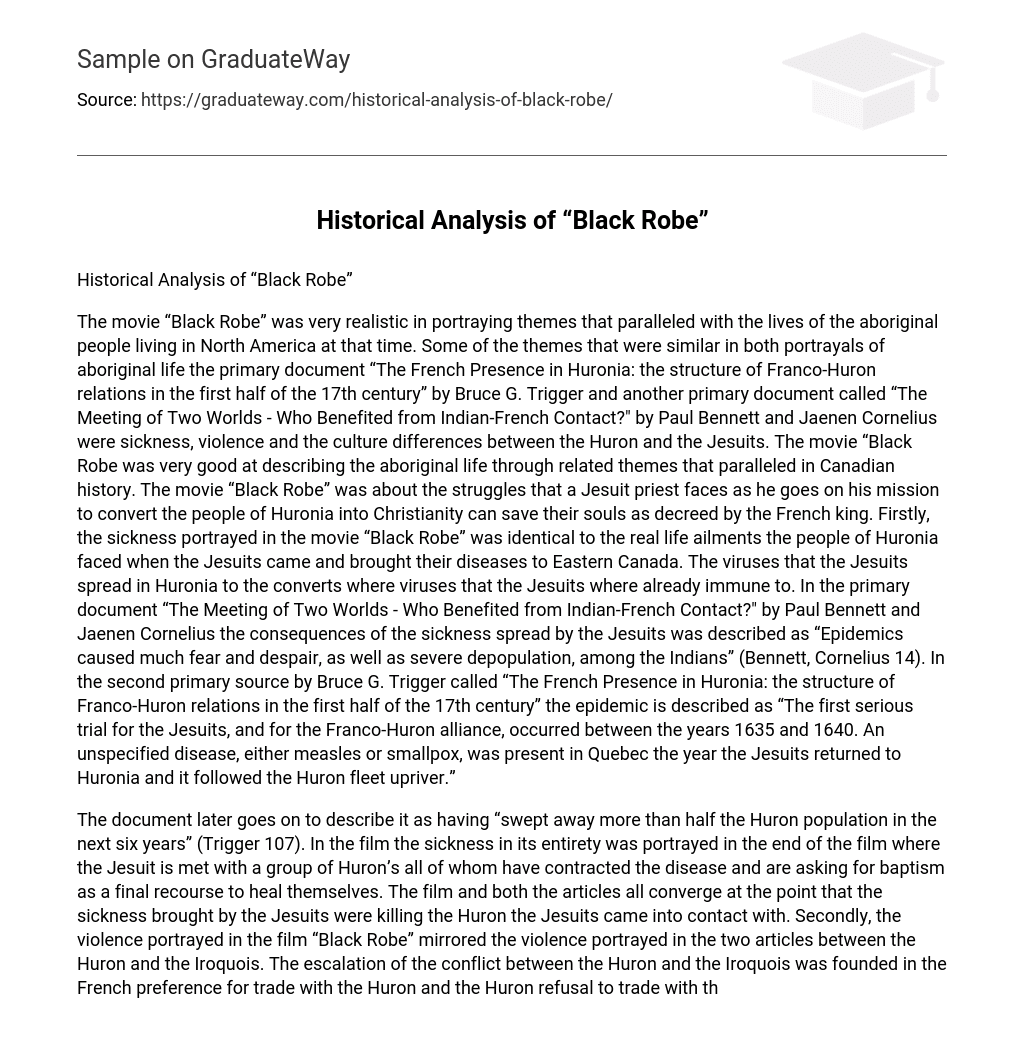The movie “Black Robe” realistically depicted themes that mirrored the experiences of indigenous people living in North America during that time period. These themes, which were also explored in the primary documents “The French Presence in Huronia: the structure of Franco-Huron relations in the first half of the 17th century” by Bruce G. Trigger and “The Meeting of Two Worlds – Who Benefited from Indian-French Contact?” by Paul Bennett and Jaenen Cornelius, included illness, violence, and cultural differences between the Huron and the Jesuits. Through these related themes, “Black Robe” effectively conveyed aspects of aboriginal life in Canadian history.
The film follows the challenges faced by a Jesuit priest as he embarks on a mission to convert the people of Huronia to Christianity, as mandated by the French king. One significant aspect portrayed in “Black Robe” is the sickness experienced by the indigenous inhabitants. This aligns with the actual ailments faced by the Huron when the Jesuits arrived and introduced new diseases to Eastern Canada. It is worth noting that these illnesses were already immune to the Jesuits themselves due to their previous exposure.
The primary document “The Meeting of Two Worlds – Who Benefited from Indian-French Contact?” by Paul Bennett and Jaenen Cornelius states that the sickness spread by the Jesuits had severe consequences on the Indians, causing fear, despair, and depopulation (Bennett, Cornelius 14). According to Bruce G. Trigger’s second primary source, “The French Presence in Huronia: the structure of Franco-Huron relations in the first half of the 17th century,” an epidemic occurred between 1635 and 1640, presenting a significant challenge for the Jesuits and the Franco-Huron alliance. The disease, either measles or smallpox, was initially present in Quebec when the Jesuits returned to Huronia and eventually affected the Huron fleet upriver.
The text explains that according to Trigger, the sickness brought by the Jesuits led to the deaths of more than half the Huron population within six years (Trigger 107). In the film, the Jesuit encounters a group of Hurons who have contracted the disease and are seeking baptism as a last-ditch effort to heal themselves. Both the film and the articles agree that this sickness caused by the Jesuits resulted in the deaths of the Hurons they came into contact with. Furthermore, the film “Black Robe” portrays violence similar to that depicted in the two articles between the Hurons and the Iroquois. The conflict between these groups escalated due to the French favoring trade with the Hurons and the Hurons’ refusal to trade with the Mohawk tribe of the Iroquois Five Nations. The Mohawk attempted to force trade with the Hurons, and when their efforts failed, they decided to destroy them (Trigger 110). The intense hatred between the Hurons and the Iroquois is most apparent in a scene from the movie where the Jesuit, Daniel, Chomina, his daughter, and a young boy are captured and tortured. The leader of the Iroquois tribe cruelly declares, “Today was but the first caress, you will die slowly, we will peel all the skin from you and you will still be alive” (Black Robe 1991).The scene in the movie showcases the animosity between the Huron and the Iroquois tribes. In this scene, three Huron men discuss their fate as a tribe and express their fear that their enemies, the Iroquois, will exploit their weakness and destroy them. This further emphasizes the lack of mercy shown by the Iroquois towards the Huron due to their long-standing grudge.
The film also highlights the significant cultural differences between the Huron and the Jesuits, as evident in primary documents. The Jesuits do not share the Huron’s belief in dreams, as stated by Paul Bennett and Jaenen Cornelius. They view the Huron’s faith in dreams, their lifestyle, mindset, and limited vocabulary for explaining religious mysteries as challenges for understanding. Similarly, in the film, the Jesuit priest expresses his fear of the devil’s influence over the people in this country and criticizes their ways.
The film accurately depicts the cultural differences between the Jesuits and the inhabitants of Huronia. According to the primary sources “The French Presence in Huronia: the structure of Franco-Huron relations in the first half of the 17th century” by Bruce G. Trigger and “The Meeting of Two Worlds – Who Benefited from Indian-French Contact?” by Paul Bennett and Jaenen Cornelius, the Huron view the Jesuits as demons practicing witchcraft. The themes of violence, sickness, and cultural difference are central to both the film “Black Robe” and the lives of the Huron people.
Citations:
– Bennett, Paul, and Cornelius Jaenen. “The Meeting of Two Worlds – Who Benefited from Indian-French Contact?” Emerging Identities: Selected Problems and Interpretations in Canadian History. Scarborough: Prentice-Hall, 1986. 1-24.
– Black Robe. Dir. Bruce Beresford. Perf. Lothaire Bluteau, Aden Young, Sandrine Holt. Alliance Communications, 1991. DVD.
– Trigger, Bruce G. “The French Presence in Huronia: The Structure of Franco-Huron Relations in the First Half of the Seventeenth Century.” The Canadian Historical Review, vol.49, no. 2, June 1968. 107-141.





